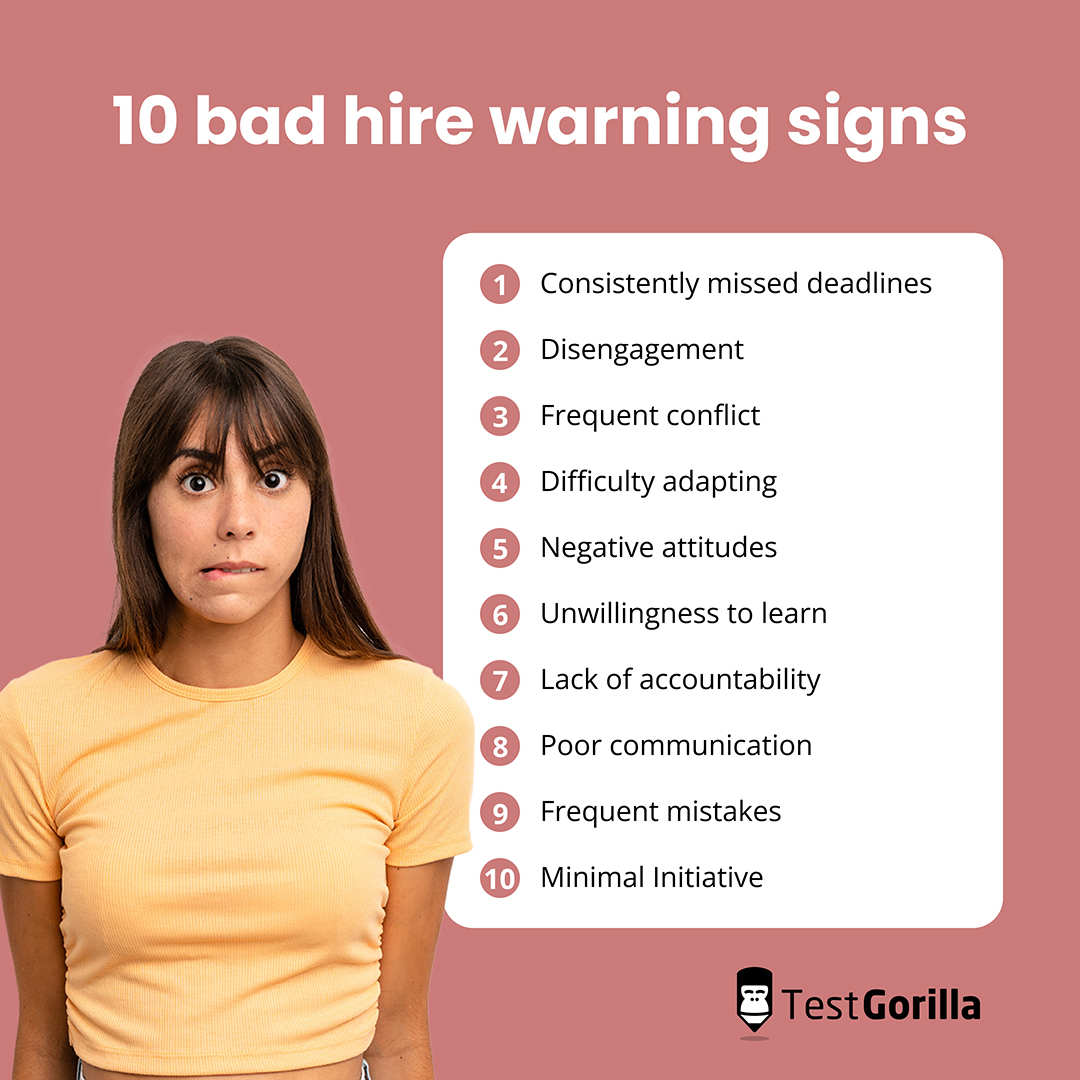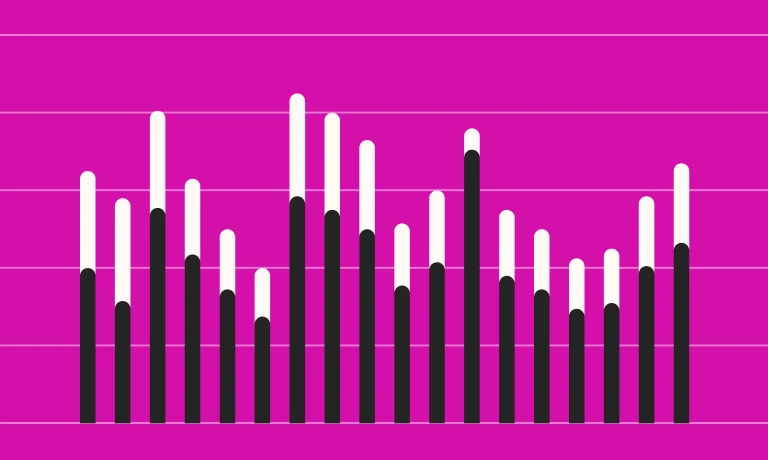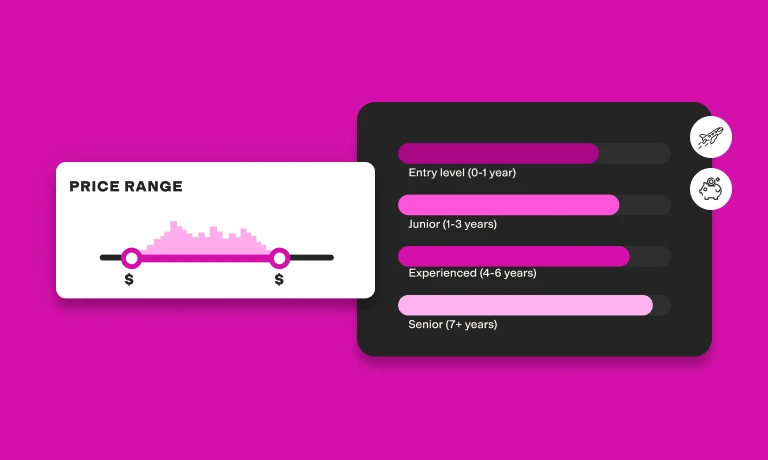A bad hire is not only a drain on your time and resources, it can have a big effect on the morale and productivity of a team and even the bottom line of your organization.
A mis-hire isn’t just someone with the wrong skills who can’t get the work done. It can also be someone who’s a poor match for your team and company culture. This individual can create friction in the workplace and affect everyone’s performance.
Fear not.
In this article, we'll guide you through the labyrinth of recruitment pitfalls, showing you how to avoid a mis-hire in the first place. You'll be armed with practical strategies to spot the 10 warning signs of a bad hire too, so you can act fast.
How to prevent a mis-hire before it happens
Before you find yourself with post-hiring regrets, here’s how to build a strong hiring strategy to pre-emptively weed out potential mis-hires.
Carefully define your job requirements
Craft a detailed list of the role's responsibilities, required skills, and desired attributes. In addition, carefully consider and clearly define what it would take to succeed in a role beyond skills. What personality traits, for example, or cognitive skills would an ideal candidate have?
If you’re not sure how to do this, check out this article on How to write great job descriptions. (You’ll find a template you can use straight away, too.)
Lean on pre-employment assessments
Resumes and cover letters might not even be written by the candidate. They can also include all sorts of claims about skills that are inflated or outright false. This makes it hard to evaluate an applicant’s true suitability for your role.
Job applications are also subject to human bias. Your hiring team could be dazzled by an educational background or an impressive previous employer, even though this doesn’t mean the applicant is the right fit.
Pre-employment skills testing are a better choice for many organizations. They objectively test skills and abilities, so you can see exactly how an individual could perform on the job.
TestGorilla, for example, has a library of over 300 scientifically validated tests. You can choose questions from a range of tests and add your own custom questions to get a clear picture of every applicant.
Prioritize situational judgment, culture fit, and personality
Bad hires aren’t just individuals who can’t do the job well. They’re also employees who cause disputes in the workplace, who don’t reflect your company culture, and who make poor decisions on the job.
Fortunately, pre-employment assessments can help here, too. TestGorilla has assessments to evaluate culture fit, cognitive skills, personality, situational judgment, and soft skills such as communication.
This way, you gain insights into applicants’ work styles, communication preferences, and how they handle challenges. You reduce the risk of a poor fit.
Use structured, recorded interviews
Instead of haphazard questioning, embrace a structured interview format. This includes standardized questions that assess technical competencies as well as cultural fit and problem-solving abilities.
In structured interviews, you might ask each applicant the same questions. For example, what’s the biggest challenge the candidate has faced in their career, and how they overcame it. This gives you insights into the talent in front of you, beyond skills testing.
One-way online interviews can be especially useful. These interviews allow candidates to record replies to your interview questions, giving you the advantage of reviewing their responses multiple times.
10 bad hire warning signs
Even with the best strategies, bad hires can happen. When they do, you’ll want to correct the situation before the issue starts affecting team productivity and your bottom line.
We’ve put together the top 10 warning signs of a bad hire to be aware of. As you read, keep in mind that occasional missteps are part of any learning curve. Even if a new employee has one or two challenges at first, it doesn’t necessarily mean all is lost.
1. Consistently missed deadlines
A few hiccups are expected, but if your new hire consistently struggles to meet deadlines and deliver on promises, it might signal a mismatch in time management skills. Be especially wary of someone who misses deadlines and doesn’t communicate about it.
2. Disengagement
A new employee who remains disconnected from team discussions and rarely contributes ideas or exhibits low enthusiasm could have a lack of alignment with your company's culture or goals.
Other signs of disengagement could include frequent absences and poor effort.
3. Frequent conflict
Frequent clashes with colleagues could point to a problem with interpersonal skills or an inability to collaborate effectively. Be especially quick to act in the case of threats or aggression, which could signal danger in your workplace.
4. Difficulty adapting
While adjustment periods are normal, a prolonged struggle to adapt to the role's demands and responsibilities could indicate a skills or experience gap. Look out for someone who doesn’t seem to understand the role and who isn’t able to meet targets even after about 90 days.
5. Negative attitudes
A consistently pessimistic outlook can be toxic to team morale and hinder progress. Watch for negative words, criticisms, and snarky comments that could underlie an undesirable approach to work.
6. Unwillingness to learn
Resisting opportunities for growth or showing an aversion to learning new skills may hinder an employee’s ability to evolve within their role.
You might notice an employee doesn’t ask questions or doesn’t complete on-the-job training. An individual may also fail to keep up with changes in the workplace or industry.
7. Lack of accountability
Failure to take responsibility for actions and outcomes can erode trust and hinder the team's progress. Be wary of employees who always have an excuse or who blame others when they face criticism.
8. Poor communication
Communication breakdowns, whether it's failing to convey information or misunderstanding instructions, can lead to confusion and misalignment.
Keep an eye out for delays in communication. An employee may also struggle to listen to or share information clearly.
9. Frequent mistakes
Frequent errors in work, beyond what is reasonable, can be a sign of a poor fit. You may notice many “oops” moments, such as not sending out communication to team members or failing to file paperwork. An employee might also miss meetings or forget details.
While everyone makes errors, a pattern of repeating mistakes without visible improvement may indicate a lack of attention to detail or poor work skills.
10. Minimal initiative
New hires who consistently exhibit a lack of initiative might not be contributing to the team's success. You may notice an employee who only does the minimum, for example, and doesn’t step up to take on new responsibilities or initiatives.
The best insights on HR and recruitment, delivered to your inbox.
Biweekly updates. No spam. Unsubscribe any time.
What to do when you’ve identified a bad hire
Realizing you might have made a mis-hire is not the end of the road. Handling the situation with empathy can still lead to a positive outcome.
Reflect
Start by evaluating the situation objectively. Is the issue a result of a skills gap, a lack of cultural fit, or perhaps a misunderstanding? Has the hire been provided with all the tools and instructions they need to do the job? Are they receiving proper support from management and their peers? Start by first ruling out any internal issues that could be putting the hire at a disadvantage.
Open communication
Initiate a private conversation with the employee. Approach the discussion with compassion and patience, explaining your observations.
Listen actively to their explanations, concerns, and insights. You might find that a new hire is facing a personal challenge or needs more clarity about their position.
Offer feedback
Provide specific examples of areas that need improvement. Offer constructive feedback and suggestions for growth, emphasizing your belief in the employee’s potential to improve. Make a written copy of the feedback valuable, too, so the employee can reflect on your ideas.
Set clear expectations
Once you’ve reviewed what needs to improve, establish a written timeline for visible progress and benchmarks you need your employee to meet. This offers a clear roadmap to work toward, with a clear deadline for improvement
Create a checklist or flow chart for the employee to refer to, too. This can remind them of the best steps to take to provide the standard of work you’re looking for.
Provide support
Provide the necessary resources, training, or mentorship. Sometimes, tailored guidance can help halt bad habits and can provide an example for a new employee to follow.
Monitor progress
Regularly touch base. When your new hire knows you will be meeting every other week, for example, they have accountability to keep trying.
In your progress meetings, celebrate small victories and offer praise for work well done. Address setbacks and continued problems together. Find out whether expectations are still unclear or whether some support is still missing.
Re-assess
Once the timeline you’ve agreed to comes to a close, evaluate whether there has been significant improvement. Positive changes show you're on the right track, even if things aren’t perfect yet.
Continued problems, past about 90 days or so, can indicate it’s time to discuss a role adjustment or, as a last resort, part ways amicably. This is especially important if a revaluation shows your bad hire is costing your organization money.
Regardless of the outcome, this experience is a learning opportunity. Consider what led to the misalignment and adjust your hiring approach accordingly.
Reduce the risk of a bad hire with pre-employment assessments
What if there was a way to get a sneak peek at how a candidate might fare at your organization? Pre-employment assessments are one way to do this.
Armed with objective measures of a candidate, you're equipped to steer clear of potential mis-hires. By combining assessments with clear job requirements and a strategy to help struggling team members, you can detect, address, and even prevent mis-hires early on.
Now that you know how to reduce the risk of hiring mistakes, you might be curious about how to use pre-employment assessments. It costs nothing to learn more. Take a product tour of TestGorilla or explore the test library today to see how assessments can help you make the right hires.
Related posts
You've scrolled this far
Why not try TestGorilla for free, and see what happens when you put skills first.



















